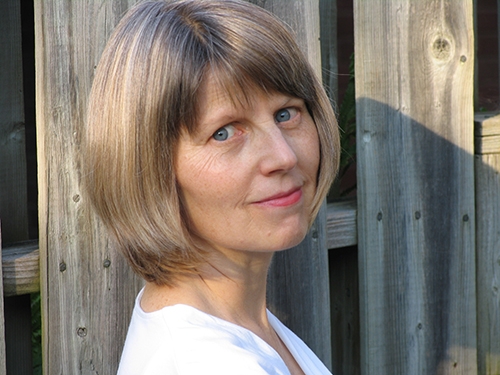Winter Comes: An Interview with Suzanne Nussey
TNQ’s Nick Blatchford Occasional Verse Contest is both funded and judged by the Blatchford family. This year’s adjudicators included a surgeon, an editor, a social services administrator, an engineer/educator, a librarian/reading specialist, a pair of artists, and the Canadian poet Amanda Jernigan who wrote the introduction to our winning poems in the fall 2013 issue of the magazine. Amanda also stepped up to the following conversation with our winning poet, Suzanne Nussey.
—Kim Jernigan
I interviewed Suzanne Nussey, the winner of the 2013 Nick Blatchford Occasional Verse Contest, in blustery November, as the season narrowed down towards the First Sunday her poem describes. Suzanne’s winning poem, “Poem for the First Sunday of Advent,” appears in TNQ 128 and is reprinted, with Suzanne’s kind permission, at the head of this interview; at interview’s end, readers will find Suzanne’s other short-listed poem, “The Passion of St Agatha.”
—Amanda Jernigan
“Poem for the First Sunday of Advent” by Suzanne Nussey
I have stripped my garden
of dead stalks and leaves,
mounded earth over the root
balls of roses and wound them
in rough brown cloth
like a poor woman’s child
or a body for the tomb.Leaf, bird and light
have flown. The world’s
reduced to monochrome,
unornamented lines,
the silent, empty air.
November’s difficult truth
is finally laid bare.I have learned to fear
what looks like death,
to cover all the possibilities
of its approach. (Small catastrophes
have been my coach.) Bad news,
disease and natural disasters
catechize my bleak imagination.So when the signs say
hunker down,
expect the worst,
I am well-prepared
for mourning,
not for birth.Winter comes.
In his book on Dante (Dante: Poet of the Secular World), Erich Auerbach suggests that it is possible that Dante’s poetry cannot be understood by a reader who does not to some extent share his worldview—which is to say, to some extent, the tenets of his faith. What would you say about “First Sunday …,” written, apparently, for an audience of fellow-believers: what sorts of understanding can readers outside of that faith-community bring to this poem?

Ernest Becker, a psychoanalytic anthropologist who taught at Simon Fraser University, Pulitzer prize-winning author of The Denial of Death, and self-proclaimed atheist, would probably have understood “Poem for the First Sunday of Advent,” though, as you observe, it was written for an audience of believers. I think the poem is accessible to readers outside a faith community in several ways.
First, I expect most people’s convictions/beliefs contain an element of doubt or uncertainty, whether it is about the object of belief or about one’s subjective self. For instance, is my relationship with my life partner really what I believe it to be? Am I the person I think I am in that relationship? Is he/she? Also, readers who are familiar with seasonal change, especially as experienced in the northern hemisphere, will understand the cycle of death and rebirth in nature that grounds the poem in physical reality. Finally, readers who have experienced loss—loss of loved ones, of livelihood, of physical or mental health—or who have lost hope that the world’s suffering will ever be adequately addressed may resonate with the persona’s struggle in the face of “death,” “disease” and “natural disasters.”
It strikes me as interesting that the question about a non-believer’s ability to understand literature written from a confessional stance is rarely turned around: Can a person of faith fully understand literature expressing views/understandings of a person who has no faith? As a believer who experiences doubt and is daily challenged with the incongruities of belief and experience, I can answer, “Most certainly!”
You mentioned in your endnote to the poem that “First Sunday …” was written to be read aloud as part of the service for the first Sunday of Advent. What role can a poet play in the context of a religious service? How do you see your words as interacting with the other words that are part of that service: those of sermon, of scripture, of hymn …
My poem was one of four literary pieces composed and read as personal reflections on each of the four scripture passages for the first Sunday of Advent in an Anglican church. The service began with a choral call and response, individual soloists performing the call and the choir and congregation responding. Next, each scripture, immediately followed by its literary response, was read. From there, the service proceeded directly into the mass, which is also structured so that the priest and the congregation are in dialogue. A continuous back and forth occurs between the individual believer (and not everyone in the community is necessarily a believer) and the universal “Church,” or “Faith,” if you will.
I understand my poem as an organic part of this liturgy, perhaps not as scripted as the rest, but providing an exploration of “the Word” from a layperson’s perspective, and, as with the music and scripture, supporting the liturgy’s great strengths: its consistency and repetitiveness in structure and message, and its predictability, all of which are aids to worship—not just the “spiritual” aspect of worship, but the “how to,” particularly in the Anglican church where physical movement is also part of the service.
For an interesting, contemporary example of how poetry can interact with scripture, check out sparkandecho.org, a U.S. arts organization that is creating the world’s largest multi-disciplinary illuminated Bible with a piece of visual, performing, or literary art covering every passage of the Bible. They commission artists from diverse backgrounds and showcase their works online and at live events.
Often, we think of great poetry as having a timeless quality: yet “First Sunday …” is a poem that explicitly positions itself in time. Its situation in time is part of its meaning. What can you say about poetry and time: is time the poet’s friend, or her adversary?
Time is a given, so I suppose the poet had better make friends with it. I tend to welcome anything that helps focus and provide structure in my writing, and so time and occasion aid me greatly. While I certainly used time as part of the meaning in “First Sunday,” I have also played with time (mixing up chronology) in other pieces, particularly in memoir writing.
In Peter Sanger’s book White Salt Mountain, Sanger quotes the poet Basho: “… indeed all who have achieved excellence in any art, possess one thing in common, that is, a mind to obey nature, to be one with nature, throughout the four seasons of the year.” Do you agree? If so, how does this relate to your sense of the possibilities for occasional poetry—or an occasional poet—working in the context of a calendar both natural and liturgical?
The writers I most enjoy reflect Basho’s observation in their work. Because the natural and liturgical calendar are pretty much in sync (Christmas and winter solstice, Easter and vernal equinox, Pentecost and summer solstice, Michaelmas and autumnal equinox), many possibilities exist for an occasional poet—whose work is grounded in what she observes and experiences in nature and reflects upon “in the flesh” and in time—to operate in this appropriately “incarnational” context.
You are the author of another poem on our shortlist, “The Passion of St Agatha.” It was, of all the poems I read in this year’s occasional-verse contest, the one that moved me to tears. Yet another of our judges, a professional surgeon, could not get past the poem’s equation of surgery and torture. I wondered if you would talk a bit about your decision to reflect on a mastectomy through the character of St Agatha.
The judge who is a professional surgeon is absolutely correct.The poem does equate that particular surgery with torture. To be precise, the procedure described in the third and fourth stanzas, just prior to the actual surgery, is called a “wire localization”; it was performed without anesthetic and it was incredibly painful. Natural childbirth was a walk in the park compared to what I experienced in those 30 minutes.
For several years after the surgery, I was unable to write about this very significant life event. I couldn’t find adequate words to articulate it and I did not want to horrify my friends and family with its description. Discovering Saint Agatha, the patron saint of breast cancer patients, allowed me to assume a persona and to find the distance I needed to communicate what happened to me that day. I don’t have much truck with the veneration of saints, but Agatha sure came to my rescue!
You will notice that there is very little passion in “The Passion of St Agatha” until the last stanza, when she is dreaming. Combining St Agatha’s voice with my experience revealed how traumatized I had been at the time of the procedure, how it rendered me speechless, then and afterwards, a “victim.”
In the poem, the third-century Agatha is a passive recipient of a highly technological treatment that she can’t fathom. She seems not to feel anything, though the reader knows otherwise. Something that is intended to heal causes intense pain that is not acknowledged, severs her from part of her identity as a woman, and leaves her with deep scars. Yet she never speaks to her “torturers.” Agatha’s “clinical” description also reveals how some of the doctors and nurses who perform these procedures also distance themselves from their patients. They seem to be as dispassionate as Agatha. No character in the poem is emotionally in touch with what is actually going on.
Ironically, Agatha, in her passivity, enabled me to make my voice heard.
“The Passion of St. Agatha: On My Clinical Mastectomy” by Suzanne Nussey
(St. Agatha was a third-century Christian martyr who suffered many tortures including having her breasts cut off. She is the patron saint of torture victims, bakers, wet nurses and breast cancer patients.)
They take your shoes,
your clothes, your ring
and leave you
with a thin, ill-fitting gown
and your name written
incorrectly on a white paper bracelet.
A woman lets you keep the shawl
your mother knitted.
You slip a tiny portrait
of your daughter into the band
around your wrist.
Then you wait
in a windowless room.When you are cool to the touch,
they wheel you down a gray corridor
to an unlit chamber.
Two women in men’s clothing
remove your shawl and scroll
your gown to your waist.
They lead you to a metal platform
where you must stand and clutch
the dark machine that sees your death.
They pull and twist your left breast
on a smooth silver plate
until a clamp locks
the kneaded flesh in place.
You wait.A man enters the room.
He will not look at your face.
The women hand him
long metal wires
which he examines.
The man adjusts the screen
attached to the silent machine.
He tells you not to breathe.
Slowly he threads one wire
into your breast.
This he repeats three times.
Your breast on the screen
is alive with steel teeth
that will tell another man
where to dock his knife.The man leaves the room.
The women tape a white cup
over the wires on your left breast.
They dress you in the thin gown.
Your shawl has disappeared.
The baby remains hidden
in your left wrist.
They leave. You wait
alone in the dark place.You are led
to the final room
where two men in white caps
spread your body on a table.
Four attending women strap
your arms, palms up,
on cool steel plates.
One man buries a tube in the hand
where your baby hides;
the other drops
a black mask over your face,
commanding you to breathe deeply.When your eyes no longer open,
you dream you walk barefoot
in red velvet robes,
bearing your orphaned breasts
like scored loaves of warm bread
on a plain wooden platter
to feed the children of the countless poor.
Photo Credit: Ken Ross

